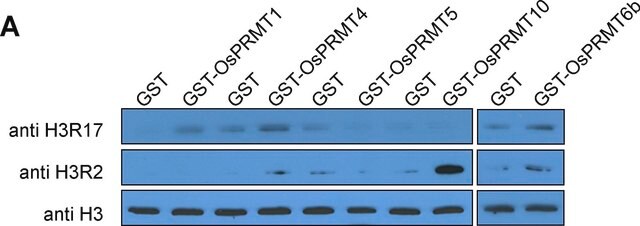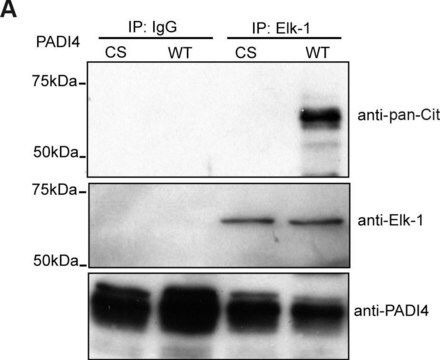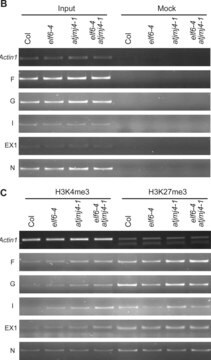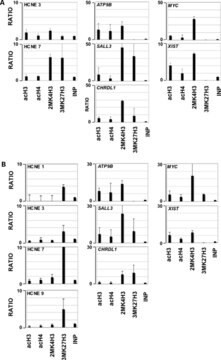17-615
ChIPAb+ Acetyl-Histone H3 - ChIP Validated Antibody and Primer Set
from rabbit
Synonym(s):
H3Ac, Histone H3 acetyl, Histone H3Ac
Sign Into View Organizational & Contract Pricing
All Photos(2)
About This Item
UNSPSC Code:
12352203
eCl@ss:
32160702
NACRES:
NA.32
Recommended Products
General description
All ChIPAb+ antibodies are individually validated for chromatin precipitation, every lot, every time. Each ChIPAb+ antibody set includes control primers (tested every lot by qPCR) to biologically validate your IP results in a locus-specific context. The qPCR protocol and primer sequences are provided, allowing researchers to validate ChIP protocols when using our antibody in their chromatin context. Each set also includes a negative control antibody to ensure specificity of the ChIP reaction.
The ChIPAb+ Acetyl-Histone H3 set contains purified rabbit polyclonal antibody and the normal rabbit IgG antibody, which can be used to demonstrate that the acetyl-histone H3 antibody is capable of precipitating acetyl-histone H3 associated chromatin. The qPCR primers included flank the human GAPDH promoter and produce a 166 base pair PCR product.
The ChIPAb+ Acetyl-Histone H3 set contains purified rabbit polyclonal antibody and the normal rabbit IgG antibody, which can be used to demonstrate that the acetyl-histone H3 antibody is capable of precipitating acetyl-histone H3 associated chromatin. The qPCR primers included flank the human GAPDH promoter and produce a 166 base pair PCR product.
Core component of nucleosome. Nucleosomes wrap and compact DNA into chromatin, limiting DNA accessibility to the cellular machineries which require DNA as a template. Histones thereby play a central role in transcription regulation, DNA repair, DNA replication and chromosomal stability. DNA accessibility is regulated via a complex set of post-translational modifications of histones, also called histone code, and nucleosome remodeling. Acetylation is generally linked to gene activation. Acetylation on Lys-10 (H3K9ac) impairs methylation at Arg-9 (H3R8me2s). Acetylation on Lys-19 (H3K18ac) and Lys-24 (H3K24ac) favors methylation at Arg-18 (H3R17me).
Specificity
Recognizes acetyl-histone H3
Tetrahymena predicted to cross-react based upon sequence of antibody generating peptide.
Immunogen
The acetyl-histone H3 antibody is made against a peptide corresponding to amino acids 1-20 of Tetrahymena histone H3 ARTKQTAR[K*]STGG[K*]APRKQL(C) where K* is acetylated)
Application
Acetyl-Histone H3 ChIP validated antibody & primer set including the ChIP-grade antibody & the specific control PCR primers used for chromatin immunoprecipitation of H3Ac.
Western Blot Analysis:
Acid-extracted proteins from HeLa cells treated with 5 mM sodium butyrate for 24 hours (Lane 2) and untreated HeLa cells (Lane 1) were resolved by electrophoresis, transferred to nitrocellulose and probed with anti-acetyl-Histone H3 (0.01 μg/mL).
Proteins were visualized using a goat-rabbit secondary antibody conjugated to HRP and a chemilumnescence detection system (Please see figures).
Acid-extracted proteins from HeLa cells treated with 5 mM sodium butyrate for 24 hours (Lane 2) and untreated HeLa cells (Lane 1) were resolved by electrophoresis, transferred to nitrocellulose and probed with anti-acetyl-Histone H3 (0.01 μg/mL).
Proteins were visualized using a goat-rabbit secondary antibody conjugated to HRP and a chemilumnescence detection system (Please see figures).
Packaging
25 assays per set. ~5 μg per chromatin immunoprecipitation
Quality
Routinely evaluated by chromatin immunoprecipitation on HeLa nuclear extract.
Target description
17 kDa
Physical form
Anti-Acetyl-Histone H3 (rabbit polyclonal IgG). One vial containing 125 ug of protein A purified antibody in 125 μL of storage buffer containing 0.1 M Tris-glycine, pH 7.4, 0.15 M NaCl, 0.05% sodium azide. Store at -20°C.
Normal Rabbit IgG. One vial containing 125 ug of normal rabbit IgG in 125 uL volume. Store at -20°C.
Control Primers. One vial containing 75 μL of 5 μM of each primer specific for for human GAPDH. Store at -20°C.
FOR: TAC TAG CGG TTT TAC GGG CG
REV: TCG AAC AGG AGG AGC AGA GAG
CGA
Normal Rabbit IgG. One vial containing 125 ug of normal rabbit IgG in 125 uL volume. Store at -20°C.
Control Primers. One vial containing 75 μL of 5 μM of each primer specific for for human GAPDH. Store at -20°C.
FOR: TAC TAG CGG TTT TAC GGG CG
REV: TCG AAC AGG AGG AGC AGA GAG
CGA
Format: Purified
Analysis Note
Control
Included negative control antibody rabbit IgG and control primers specific for human GAPDH promoter.
Included negative control antibody rabbit IgG and control primers specific for human GAPDH promoter.
Legal Information
UPSTATE is a registered trademark of Merck KGaA, Darmstadt, Germany
Storage Class Code
10 - Combustible liquids
Certificates of Analysis (COA)
Search for Certificates of Analysis (COA) by entering the products Lot/Batch Number. Lot and Batch Numbers can be found on a product’s label following the words ‘Lot’ or ‘Batch’.
Already Own This Product?
Find documentation for the products that you have recently purchased in the Document Library.
Characterization of Toxoplasma gondii subtelomeric-like regions: identification of a long-range compositional bias that is also associated with gene-poor regions.
Dalmasso, MC; Carmona, SJ; Angel, SO; Aguero, F
BMC Genomics null
Rachna Sehgal et al.
Developmental biology, 332(2), 429-443 (2009-06-10)
Pax2 is essential for development of the neural tube, urogenital system, optic vesicle, optic cup and optic tract. In the eye, Pax2 deficiency is associated with coloboma, a loss of astrocytes in the optic nerve and retina, and abnormal axonal
Richard D Palermo et al.
PLoS pathogens, 7(10), e1002334-e1002334 (2011-11-03)
Epstein-Barr virus (EBV) immortalizes resting B-cells and is a key etiologic agent in the development of numerous cancers. The essential EBV-encoded protein EBNA 2 activates the viral C promoter (Cp) producing a message of ~120 kb that is differentially spliced
Regulation of cyclin B2 expression and cell cycle G2/m transition by menin.
Wu T, Zhang X, Huang X, Yang Y, Hua X
The Journal of Biological Chemistry null
Dandan Niu et al.
Cancers, 2(3), 1689-1704 (2010-01-01)
Deleted in Lung and Esophageal Cancer 1 (DLEC1) is a functional tumor suppressor gene (TSG). It has been found to be silenced in a variety of human cancers including hepatocellular carcinoma (HCC). The silencing of DLEC1 can be modulated by
Our team of scientists has experience in all areas of research including Life Science, Material Science, Chemical Synthesis, Chromatography, Analytical and many others.
Contact Technical Service








